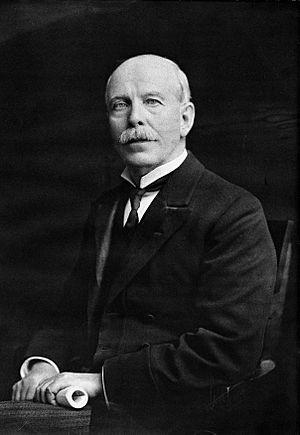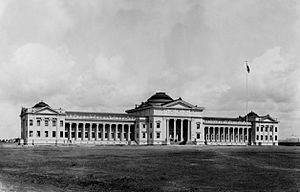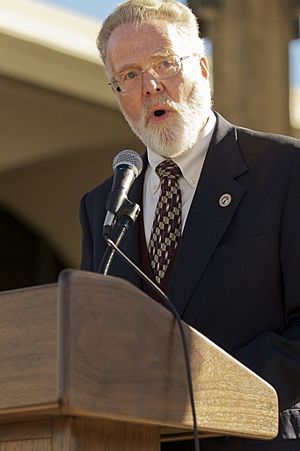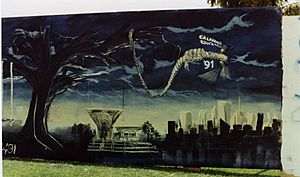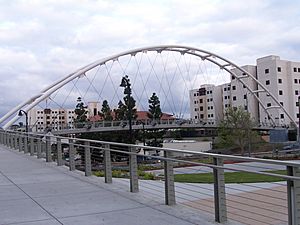History of San Diego State University facts for kids
The history of San Diego State University (SDSU) began in the late 1800s. It started as a normal school in San Diego, California. The school opened on November 1, 1898, with 135 students. By 1921, it became San Diego State Teachers College, which meant it could give out degrees. More students joined, so the college moved to its current spot in Mission Valley. Classes started there in February 1931. Government projects during the Great Depression helped build many new buildings on the campus.
Both World War I and World War II changed how many students attended. Many students and teachers joined the armed forces. By the late 1950s, there were 10,000 students. The school, now called San Diego State College, was the fourth largest state school in California. In the 1960s and 1970s, even more students enrolled. Its special schools became officially recognized. There were also many student activities and protests. On January 1, 1974, the school got its current name: San Diego State University (SDSU). By 1987, the university had almost 36,000 students. It became the largest university in California and the tenth largest in the nation.
Recently, the university has worked to improve its academic standing. It has also faced challenges, including a difficult event in 1996 and a large law enforcement operation in 2008. SDSU continues to offer many degrees in different subjects. It has also made plans to build new buildings and update older ones.
Contents
How San Diego State University Started
In the late 1890s, leaders in San Diego wanted a normal school (a school to train teachers). This would help the town grow and train more teachers. It was expensive for people to travel to other normal schools. San Diego wanted its own school closer to home. The city had to compete with Fresno, Los Angeles, and other cities. Their first try in 1895 was stopped by California Governor James Budd.
But on March 13, 1897, Governor Budd changed his mind. He signed a law that gave $50,000 to start a state normal school in San Diego. It was planned for University Heights. By 1905, the school had received a total of $333,300.
The first group of leaders for the San Diego Normal School met on June 3, 1897. They chose Samuel T. Black as the school's first president on October 1, 1898. He had been the state superintendent of public instruction for California.
The new school building was designed by the firm Hebbard and Gill. Architect Irving Gill created the building in a Beaux-Arts style. Construction started on August 1, 1898. The building was officially opened on May 1, 1899. While the building was being built, the first classes were held in downtown San Diego, starting on November 1, 1898. Classes moved to the new Normal School building in May 1899, even though construction was still going on. By the end of the first year, 135 students were enrolled. Most of them were women. By 1910, enrollment grew to 400 students.
In the summer of 1899, San Diego Normal School was the first normal school in California to offer summer classes. On June 21, 1900, the first class graduated, with 23 women and three men. More rooms were added to the building later that year. In 1903, the state gave $61,000 for a west wing. This new part included a gym, library, labs, and lecture rooms. It was finished in September 1904. In 1906, a new law said students needed a high school diploma to get into a normal school. This was the same rule as for the University of California.
In 1910, Samuel Black left, and Edward L. Hardy became the new president. He increased the number of teachers from 19 to 27 by 1912 to handle more students. More buildings were added, and by 1910, space was limited. The school stopped offering a high school program, but still taught elementary and middle school grades. Most students at the school were from the San Diego area.
Impact of World War I
World War I greatly affected the school. A strong feeling of patriotism led the school to ask students to say the Pledge of Allegiance to enter. The war also caused fewer students to enroll. All male students gradually left to join the war effort. In 1918, there was only one male student left. Some teachers also joined the military. With fewer students, the remaining teachers had time to improve their own skills. On campus, students and teachers worked with the Red Cross. They also organized drives to sell bonds and sent packages to soldiers overseas.
During this time, President Hardy worked to make the school a college. In 1921, California lawmakers made the school a four-year teacher's school. On July 28, 1921, the San Diego Normal School became San Diego State Teachers College. With this new status, the college could now give out degrees. Before this change, the school had graduated 1,500 teachers. It had also helped the city grow.
In 1921, the legislature moved San Diego Junior College to the college campus because it was too crowded at San Diego High School. The junior college stayed with the school until 1947, when it became independent.
On June 30, 1923, the college could start giving Bachelor of Arts degrees. These included subjects like accounting and engineering. By 1928, the college could also offer special training for high school teachers in subjects like English, history, and chemistry.
Moving to the Current Campus
The first Normal School building was made for only 600 students. By 1922, President Hardy suggested building a new campus on a 125-acre plot near Balboa Park. But San Diego voters said no. In 1925, California lawmakers allowed a move to a new site. This would happen if San Diego bought the old school building and provided a new location.
Over the next few years, many locations were suggested and voted down. Finally, in June 1928, the Bell-Lloyd Investment Company offered 125 acres at Mission Palisades. This site was on the east side of Mission Valley, about 10 miles from the old school. The company hoped this new campus would help create a new shopping and housing area. Before the new campus could be built, San Diego voters had to agree to buy the old site. They voted yes on May 15, 1928. After the move, the old Normal School building was used for a junior high school and offices. It was taken down in 1955 to make way for a new building.
George B. McDougall was chosen as the main architect for the new campus. Construction began on October 7, 1929. The first classes with 1,220 students were held at Montezuma Mesa in February 1931.
The Great Depression helped San Diego State Teachers College. The government provided money for building projects to help the economy. This led to new buildings on campus, like a $500,000 stadium finished in 1936 and an open-air theater finished in 1941. Several government programs also created jobs for students and increased financial aid.
In June 1935, President Hardy retired. Walter R. Hepner took his place. The bell tower on campus was named after Hardy in 1976. On September 15, 1935, the California legislature removed "teachers" from the names of state colleges. So, San Diego State Teachers College became San Diego State College (SDSC). In 1935, the college started offering engineering classes.
Impact of World War II
World War II also had a big impact on the college. Just four days after the attack on Pearl Harbor, thirteen students left to join the military. Student enrollment dropped from 2,077 in 1940 to only 860 in spring 1943. The number of teachers also went down. Before the war ended, 3,500 people connected to SDSC joined the armed forces. 135 of them lost their lives. Many joined the Navy, which was not surprising for a city with a large naval base.
In 1942, the campus became a War Information Center. This center helped boost people's spirits and practiced air raid drills. Things like sugar, gas, and paper were limited on campus during the war. Classes were changed to focus more on science and technology. Most sports were canceled, and drives were held to send supplies to troops.
As the war ended, enrollment went up. By 1946, there were 2,000 students. Almost half of them were veterans who received money to help with housing and tuition. Sports and activities returned to normal. By the end of the 1940s, the number of teachers had grown to 230.
In 1946, President Hepner organized the different subjects into seven main areas. In 1950, the college gave out its first master's degree. By the end of the decade, it offered master's degrees in 38 subjects. On May 23, 1947, Governor Earl Warren signed a law making SDSC an official four-year liberal arts school.
Growth and Changes After the War
In 1952, President Hepner retired, and Malcolm Love became the new president. At this time, the college had over 4,800 students and 222 teachers. It offered 27 main subjects.
By the end of the 1950s, the student population was over 10,000. This made it the fourth largest state school in California. In 1957, new students' test scores were among the top 10% of all universities in the U.S. To keep up with the growing number of students, the size of buildings and classrooms greatly increased.
In 1959, the school started offering classes in El Centro. In 1960, it became the first California state college to have an educational radio station, KPBS-FM.
Before World War II, less than 25% of teachers had doctorates. To become a university, the school decided that new teachers needed to have their doctorates. By the end of the 1950s, 56% of permanent teachers had doctorates. By 1965, this number grew to 68%.
During a time when people had strong worries about certain political ideas, a psychology professor named Harry C. Steinmetz was questioned. He was later removed from his teaching position.
On July 1, 1961, SDSC became part of the California State College system. This brought new rules and a statewide board of leaders. The school continued to grow, with 10,700 students in 1960 and 25,500 in 1970. A local leader said that it would be hard to run the county without the help of San Diego State graduates.
John F. Kennedy, who was the U.S. president, gave a graduation speech at Aztec Bowl on June 6, 1963. About 40,000 people were there. Kennedy received an honorary degree, making San Diego State the first in California to give such a degree. To remember his visit, a marker was placed where his helicopter landed. On May 29, 1964, Martin Luther King Jr. spoke at the Open Air Theater about improving rights for African Americans.
In 1965, San Diego State started offering a doctorate degree in chemistry with University of California, San Diego. By 1991, the campus had eight different doctorate programs. Research became very important for teachers in the 1960s. By 1965, teachers at SDSC had written over 200 books. Government money for research also greatly increased.
In 1966, President Love was named one of the best college presidents in the country. He changed the college's structure, turning its main areas into professional schools. This helped the school get closer to becoming a university. He said that even though they were called a college, they were truly a university.
Student Activities and Protests
The late 1960s and early 1970s saw many student protests and changes. Students mainly protested against unfair treatment and the war in Vietnam. In March 1970, 600 students held a week-long sit-in. They were protesting the school's decision not to rehire four teachers. Protests also happened against military training groups and military recruiters on campus. Important speakers visited the campus, including Cesar Chavez, Jane Fonda, and Angela Davis.
On April 20, 1972, some demonstrators held military training students during an exam. The students were released peacefully. On May 3, 1972, some protesters broke windows and started small fires in buildings. This caused some injuries and damage. On May 24, 1972, a small explosion happened in a building, injuring a student. A group of African American students marched on campus to show support.
The first women's studies program in the United States started at the college in 1970. This happened after a year of hard work by women's groups, rallies, and petitions.
In early 1971, President Love retired. A new library was named in his honor. After a short time with an acting president, Brage Golding became the new president in 1972. He served until 1977. He helped bring in skilled leaders who would improve the school. He also started a research center for the city's history and a program offering classes for older people.
Thomas B. Day became the sixth president in 1978. When a new law called Proposition 13 passed, the school faced money problems. President Day suggested cutting some departments and teachers. However, these cuts were later found not to be needed.
President Love had worked hard to change SDSC from a college to a university. In 1972, California lawmakers approved renaming the school to "California State University, San Diego." But San Diego State officials still wanted a different name. On January 1, 1974, it was renamed "San Diego State University" (SDSU), which is its name today.
Recent History
In 1987, the school had its highest number of students, with 35,945. This made SDSU the largest university in California and 10th in the nation. Because there were so many students, the California State University leaders decided to limit enrollment to 33,000. However, in 1993, enrollment dropped to 26,800, the lowest since 1973, due to money problems.
In the 1980s, SDSU's business school was highly ranked. Its accounting program was the only one in California to be officially recognized. Students from SDSU scored very well on the Certified Public Accountancy (CPA) exam.
In 1991, the California state government proposed big money cuts to the state university systems. SDSU faced a long period of money problems, teacher concerns, and student protests against fee increases and class cuts.
In spring 1991, there were large fee increases and budget cuts. SDSU's president at the time, Thomas Day, chose to make deep cuts in specific areas. This led to the largest student marches and protests since the Vietnam war era.
In spring 1992, the university systems faced more budget cuts and big student fee increases. President Day again proposed deep cuts, including removing some majors like Aerospace Engineering. A large meeting was held, but it became chaotic. Students felt let down, and some held a temporary protest in President Day's office. This led to a 24-hour vigil, student trips to the state government, and more protests. Because of pressure from students, teachers, and the public, the university system's leader eventually stopped President Day's deep cuts, saving the majors and programs in fall 1992.
During these protests, an 8-foot-high wooden fence around a new campus building became a "Student Free Speech Wall." Students put up protest messages, paintings, and cartoons. President Day tried to paint over the wall, but a large police force arrested eight students who were peacefully sitting in front of it. The next morning, more students rushed to the wall and stopped the painters.
In May 1994, the student government created a permanent memorial to the wall. It included a painting of President Day's head.
When President Day retired in July 1996, Stephen Weber became the university's seventh president. Just one month later, on August 15, a sad event occurred when three professors were killed. A memorial was dedicated to the three professors on August 23, 2003, with three trees, tables, and benches.
On July 10, 2005, a new trolley station opened on the SDSU campus. This station connected students and teachers to other parts of San Diego county. It also helped with the lack of parking around campus. The $103 million station was one of many building projects in the 2000s. Starting in the late 1990s, a $500 million project led to new apartments, fraternity houses, and plans for more housing, shops, and offices. In 2003, a pedestrian bridge opened, connecting some dorms to the main campus. In the same year, the campus's largest and most advanced classroom was finished. Through 2008 and 2009, the campus worked on a new alumni center and added more office and classroom space.
In June 2007, SDSU was named the number one small research university in the nation. This was based on how much research teachers did, awards they received, and research grants. The campus usually has about 800 studies happening at any time. A 2007 study showed that the campus adds $2.4 billion to the San Diego area's economy. This amount is expected to grow to $4.5 billion by 2025.
On May 6, 2008, law enforcement announced the arrest of 96 people, including 75 San Diego State University students, in a large operation. Several months later, most of the people involved pleaded guilty. They were either put on probation or had to join special programs.
In 2010, after 15 years as president, Weber announced he would retire the next year. He was praised for improving the graduation rate. In May 2011, Elliot Hirshman was chosen to replace Weber. Hirshman became president in July.
After the San Diego Chargers football team moved to Los Angeles in 2017, SDSU worked to gain control of the city stadium (then called Qualcomm Stadium) and nearby city land. This land is across the freeway from the main campus, and SDSU football games are played there. The plan, called SDSU West, was approved by city voters in November 2017. On May 29, 2020, the city council agreed to sell 135 acres, including the stadium, to San Diego State for $88 million. SDSU started building a new 35,000-seat stadium in August 2020. The stadium will host SDSU football games, other college games, professional soccer, and special events like concerts. The entire $3.5 billion project, which includes housing, offices, shops, hotels, and 80 acres of parks, will be built in stages over 15 years.


